An obvious drawback is the lack of a flat surface around the opening, resulting in a severe limitation of the extrusion width to exactly the nozzle width (plus some percent). This nozzle cannot efficiently push the filament against the nearby perimeters because it cannot constrain its height and it cannot flatten the top of the already extruded one. So layer adhesion may not be a big problem, but perimeter-to-perimeter likely is.
Also, the thinner wall and extended length will reduce the filament temperature, however I don't know whether a simple compensation would do, since cooling will depend on filament speed and travel speed.
Regarding the cooling, you can check also the original designer's goal:
A big problem with small. hot and slow prints is the heat radiation of
the hotend and nozzle itself. To get as little as possible heat into
the print, the nozzle needs to be as long and pointy as possible. The
longer the nozzle, the bigger the distance between heater block and the
print. And the more pointy it is, the less heat radiation can affect
the print. A nice side benefit: the cooling fan can blow better onto
the print and "around" the nozzle.
